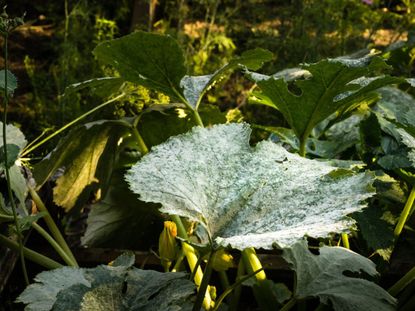Powdery Mildew Control On Squash: Treating Powdery Mildew In Squash Plants


We often have the perfect storm of summer weather conditions to contribute to a severe infection of powdery mildew on squash, specifically our butternut and spaghetti squash. The squash leaves with mildew die back, exposing the fruit to sunscald at its formative stage. It's not uncommon for squash leaves to have powdery mildew, but since it affects yield, how can you go about treating powdery mildew in squash? Read on to learn more.
Squash with Powdery Mildew
Powdery mildew spreads rapidly and can travel a long distance. In addition to squash plants, it may afflict any number of veggies, including:
However, there is a different species of powdery mildew that attacks each different veggie. In the case of cucurbits, there are three different fungal species responsible for causing powdery mildew: Podosphaera xanthii, Golovinomyces cucurbitacearum, and Golovinomyces orontii. Contrary to what you might think, powdery mildew on squash is not prevalent during wet growing seasons. In fact, moist conditions are not necessary at all to foster this fungus, and it quite likes it hot. Hence, the aforementioned “perfect storm” is an unusually dry, hot summer. So how do you identify powdery mildew in squash? This disease is fairly obvious in appearance. It appears on older leaves first, as reddish-brown spots. At the onset, the disease can only be identified via microscope, but quickly it will become apparent as it rapidly spreads to create white, mildew-covered leaves, petioles, and stems. This powdery mycelium makes the leaves appear to have been dipped in talc. The leaves lose their normal dark green hue, turn pale yellow, then brown, and finally shrivel, leaving the squash exposed to sunburn. Conidia (spores) are rapidly produced in the powdery mycelium and any wind or air movement carries them to adjacent plants and leaves as well as off to plants situated even farther away. In fact, it only takes three to seven days from initial infection to appearance of symptoms. Powdery mildew thrives in dense plantings, shaded to low light exposure and high relative humidity. Infection can occur anywhere between 50-90 F. (10-32 C.), but it favors warmer temps up to 80 F. (26 C.), but not over 100 F. (37 C.). Also, powdery mildew in cucurbits is spread because the disease overwinters and is spread to successive generations of squash.
Powdery Mildew Control
Along with the perfect storm of weather conditions, we no doubt aid and abet the disease. As mentioned above, the disease overwinters. Practicing crop rotation will go a long way in preventing the spread of powdery mildew. Do not plant cucurbits in the same area for at least two years. We did not always practice crop rotation; I blame my other half. Additional management techniques for treating powdery mildew in squash are to destroy any diseased plant debris, space plantings since a densely planted plot are more likely to be infected, and plant resistant varieties when possible. Also, keep the garden free of weeds. Powdery mildew control may also need to be combined with a timely application of a fungicide. When using fungicides, it's too late for them to be of any use once symptoms become rampant. Fungicides work by preventing infection of healthy foliage, so find the infection early. There are a number of organic options available as well as traditional fungal sprays.
- Sulfur and “Stylet” oil are effective products for powdery mildew control.
- Fixed copper fungicides have also shown results in managing powdery mildew.
- Neem oil is also an effective combatant for managing powdery mildew.
Whatever you choose, remember the key is an early application, before the disease is readily apparent all over the foliage.
Gardening tips, videos, info and more delivered right to your inbox!
Sign up for the Gardening Know How newsletter today and receive a free download of our most popular eBook "How to Grow Delicious Tomatoes."

Amy Grant has been gardening for 30 years and writing for 15. A professional chef and caterer, Amy's area of expertise is culinary gardening.
-
 Does Gardening Reduce Carbon Footprint Size?
Does Gardening Reduce Carbon Footprint Size?If you’d like to learn how to reduce your carbon footprint on the Earth, start with your garden activities and planting decisions.
By Bonnie L. Grant
-
 How To Use Less Plastic: 5 Ways To Go Greener In Your Garden
How To Use Less Plastic: 5 Ways To Go Greener In Your GardenData on how our overuse of plastic is harming the planet may leave you wondering how to use less plastic. Here are ideas for reduced plastic use in the garden.
By Teo Spengler